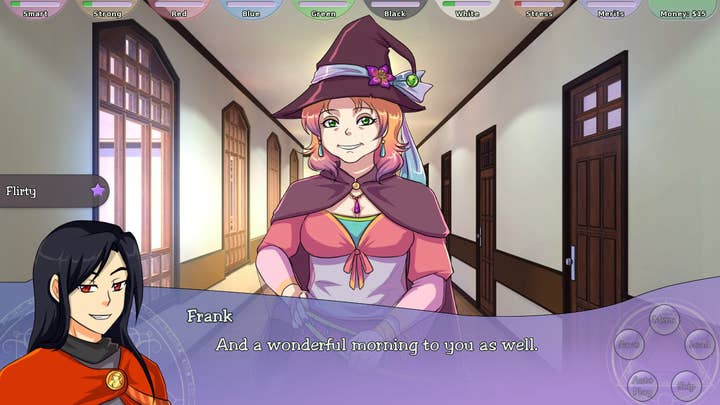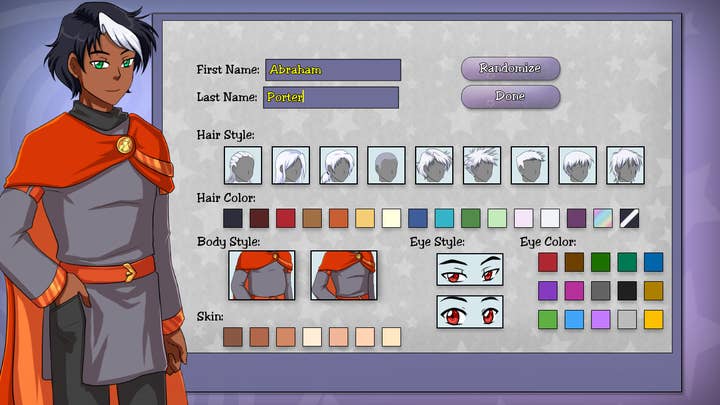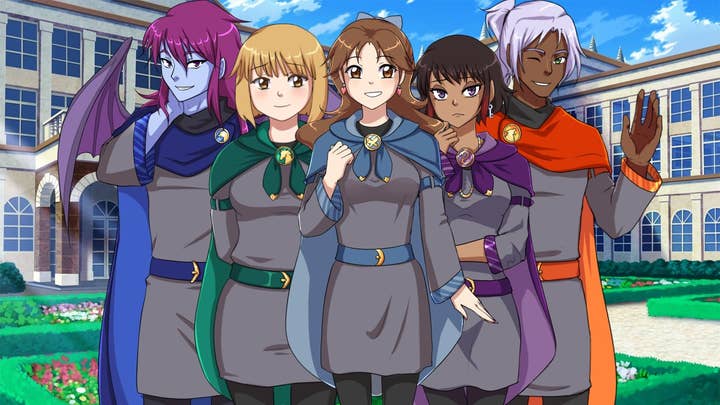How Hanako Games designs for growth
Georgina Bensley on using Kickstarter as a model for offering world-building rewards with Magical Diary: Wolf Hall
To call Georgina Bensley a visual novel and life sim veteran would be an understatement. She's been publishing interactive fiction online since at least 2000 and made her first title as Hanako Games in 2003.
"My games usually draw influence from scifi/fantasy, anime, visual novels, RPGs, adventure games, and old-school pick-a-path gamebooks," Bensley says on her Patreon. "I love branching choices and complicated consequences!"
Indeed, Bensley's most complicated game to date is 2020's Magical Diary: Wolf Hall, a gigantic dating and magical school sim that's a direct sequel to Hanako's 2011 game Magical Diary: Horse Hall. The original game follows a female student at the mysterious Iris Academy during a year of school, a structure Bensley enjoys and used again for 2016's Black Closet and Wolf Hall.
"With a long and complex writing project, it's very helpful having the enthusiasm of testers who are guessing and suggesting where the story might go"
In Wolf Hall, the player character is a teenage boy from a magical nation in Europe who's sent for a study abroad year at an American magic school. He meets a variety of students, twelve of whom have story routes ranging from fun and eccentric friendships to full-on lasting romance. The structure involves choosing daily classes that boost different magic skills, and these are tested both in storytelling and the school's practical exams in the dungeon. A student with strong skills might detect traps and glamors in real life as well as the dungeon. And a student who's kinder to their fellows might understand more of Wolf Hall's complex social dynamics.
"The original Magical Diary: Horse Hall was the first game that I had a 'paid alpha' for, where people could buy into the game before it was finished," Bensley says, speaking to GamesIndustry.biz. "The Magical Diary games are large and complicated, not just in terms of the writing structure with lots of routes and choices and optional scenes, but with the RPG aspect of the dungeons and the huge combination of spells available and how they interact with the environment."
Hanako Games is staunchly independent with a devoted following, and for Bensley, crowdfunding on Kickstarter opened up a way to both increase interest and get a steady supply of feedback-backers willing to pay a little more got access to a paid alpha.

"Because there are so many possible roads through the story, it felt really important to get as many testers on board as soon as possible to try things we hadn't thought of, rather than waiting until the game was mostly finished and then getting people to check that it 'works'," she explains. "With a long and complex writing project, it's also very helpful having the enthusiasm of testers who are guessing and suggesting where the story might go and openly reacting to new developments. It keeps me going."
The Wolf Hall campaign was full of modular stretch goals, adding entire character routes if individual funders gave $1,000. These even followed characters from Horse Hall, making the upsell an opportunity to play a story they may have wanted for years.
"None of the side routes would exist without the Kickstarter backing, because those weren't the stories I was gearing up to tell"
"None of the side routes would exist without the Kickstarter backing, because those weren't the stories I was gearing up to tell," Bensley explains. "All these characters had potential, and the Kickstarter allowed people to tell me what and who they wanted to see more of. I was actually surprised that some people were willing to pay a $1000 buy-in to guarantee a specific character without having specific ideas of what they wanted. I had expected that anyone who was that invested would come in with a huge list of demands, but it didn't work out that way."
Instead, people had stronger opinions about things that were easier to adjust, Bensley says, like smaller details that didn't influence character routes or endings. The large rewards went fast and helped to outpace the original goal, but Bensley knew she'd be able to scale up as needed.
"Because I've been around a while and have completed many games before, I wasn't too worried about the project size getting wildly out of hand," she says. "It did get a lot bigger than originally envisioned, but not to a level I couldn't manage it. I was careful not to promise anything that I couldn't pull together with a backup plan if the original fell through."
In fact, the campaign tripled its modest $10,000 goal and had over a thousand backers.But Bensley remained canny about the scope. Her "backup options" included layers of redundant planning and providers she could fall back on, especially for the single tier that offered physical rewards-something Bensley was hesitant to offer at all..
"I was extremely careful about offering physical rewards because I've seen what a logistical nightmare that can turn into"
"I had the cash on hand to hire someone else to do things over again if the first person I hired to do them disappeared partway through and took their pay with them," she explains, "which is always a risk when doing online business. If the physical goods had gone astray or the company making them had folded during fulfillment - which almost happened - I would need to be able to order a second batch."
The only limited reward tier that didn't sell out was also the only one to offer merchandise in lieu of a character or game design, and making this a small group was intentional.
"[O]n the cautionary front I was extremely careful about offering physical rewards because I've seen what a logistical nightmare that can turn into, especially when it's not even your main product but it ends up sucking up all of your time to manage," Bensley explains. "I did only a tightly-limited number that I knew I could handle on my own and, again, could find a way to replace if something went horribly wrong."

All of this works, Bensley says, because of her hybrid approach in her games.
"Magical Diary is more of an RPG in plot approach. It's supposed to be 'your' character to a much larger extent than most [visual novels], so there need to be options for players to express themselves differently. Player suggestions and requests make sense to add in."
Even so, she was surprised by the extent to which players wanted to look a very specific way. The final game has a dozen hairstyles and a dozen colors that include a pearlescent rainbow color, gray to purple ombré, and a "skunk stripe." At an in-game shop, players can spend a weekly allowance on cosmetic accessories as well as magical items.
"I had originally not bothered putting in as many design options for the male [player character] as for the female PC because I didn't think people would care as much about designing a male character," Bensley says. "The first builds didn't even have wings as an option for a male, but an early preview tester was disappointed so I changed directions. Someone specifically asked about adding multi-colored hair, so I tinkered with ideas and that's how we ended up with the 'unicorn rainbow' and 'skunk stripe' options."
That also led to expanding some character options out of mainstream VN choices, including a larger body type and NPCs who are nonbinary or genderqueer.
"Multiple people wanted to create characters who didn't fit into the strict gender binary. One backer specifically wanted a larger body type"
"[A]s I was collecting people's ideas for the characters they wanted to put into the game, some gaps in the available art became apparent. Multiple people wanted to be able to create characters who didn't fit into the strict gender binary. One backer specifically wanted a larger body type for his insert character, and other people had mentioned being sad that the option was not available for the male PCs."
Traditional stretch goals filled out some technical requirements, like the option to customize your character even more and the addition of more music and art.
"With many elements I didn't specify exact details or amounts," Bensley says. "How long is a side route? However long as I need it to be. How many graphics are 'extra graphics'? As many as I feel like. So I could meet those standards in many different ways depending on time and budget."
The early buy-in from Kickstarter backers differs in key ways from something like Steam Early Access, Bensley explains, and she wanted the kind of feedback dedicated backers would offer, while letting others effectively preorder the game and then wait.
"I did not want to go the 'Early Access' route on Steam because in my opinion that can end up draining enthusiasm from a story-based game as they wait for it to be completed, and leave the eventual full-launch feeling like an afterthought rather than a celebration," she explains.
As the campaign doubled and tripled its original goal, Bensley had a new logistic to consider. Early bird backers received the game for about $20, with beta testers at $25. Charging more for a feedback role, Bensley says, brought in "enthusiastic" testers who want to see new material as it emerges and are excited to talk about it.

"My concept of average indie game price fluctuates over time as the industry moves, but tends to sit around $20 for a solid, not short but not hugely flashy game, whose price may drop over time as it becomes outdated," she says.
That maps with her back catalog, which extends back almost 20 years at this point. The 2012 royal death sim Long Live the Queen is just $10, while newer Black Closet is still $20.
"So for all the months that I was pushing through writing, the beta was on sale for $25," she explains. "The word count for the game kept climbing higher and higher as I worked through all the storylines, and the beta kept steadily selling at that price, and eventually I decided that $25 really was a more appropriate price for the final product. After all, that original $20 vision was a game with five routes, not 12!"
"Most of what I've seen go wrong with crowdfunding is people with big dreams and no experience who don't know how to scope a project"
Bensley was careful about choosing Kickstarter, and she knew the design of Wolf Hall could flex a great deal to absorb new and enlarged features. She also had a base of fans who loved the first game. For her, that means Wolf Hall was a special case that succeeded with crowdfunding, not necessarily a template for future games. She had clear goals and understood that they were likely to succeed.
"Most of what I've seen go wrong with crowdfunding is people with big dreams and no experience who don't know how to scope a project and don't know how to keep on top of it to get things to a release state," she says. "It gets to be too much work, which they never budgeted for, and they panic and run away, never to be seen or heard from again."
Scoping a project is hard without the right skillset-crunch culture indicates that even big developers refuse to listen to project managers-but on Kickstarter the problems can go a step further. Projects may have high budget goals but not offer enough information, transparency, or detailed plans to persuade the number of backers they need. Treating stretch goals with the snowball method, where they gain momentum as they roll "downhill," can help backers feel that a project is more exciting and successful.
Some developers end up with a fully funded project, but inadequate budget, Bensley says.
"A few run a second campaign to ask for extra funds to try and complete the project. This gets made fun of a lot, but it's generally a better approach than the cut-and-run, especially if you've actually learned something by this point about what you need to get the project done."
So maybe Bensley won't Kickstart every game, but it's also hard to sneeze at a tripled budget and a game that nearly tripled in size and scope.
"I'm not sure right now how I feel about crowdfunding for future titles," she says. "With smaller games, or games where I already know everything that's going into them and don't have much wiggle room to offer crowd-suggested options, I don't think as many people would be interested. I might attempt a small campaign as part of a general pre-launch advertising strategy and see how it works out."
